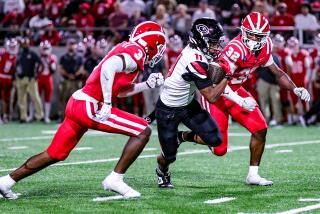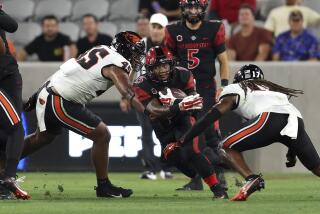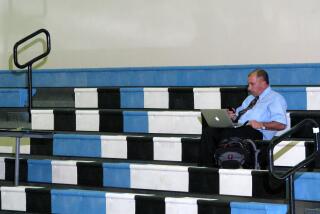COLLEGE FOOTBALL ’92 : It’s Just Nevada : The Wolf Pack Wants the Hyphen and Reno to Go the Way of Its I-AA Status Now That It Has Joined the Division I Big West Conference
RENO — Having registered their best football season in 1991, which included one of the more memorable comebacks of all time, the folks at the university on the hill in Reno decided to celebrate.
They decided once and for all time to rid themselves of something very small that has been a very big irritant.
That hyphen.
From now on, they want to be known as the University of Nevada. Period. No hyphen, no comma. No more University of Nevada-Reno. Or Nevada, Reno. Or even worse, UNR.
The school was known as just Nevada for years and years until that new school in the Southern part of the state hired a coach named Jerry Tarkanian and became a national basketball powerhouse. Citizens of Reno felt the hyphen was forced on them and always resented it.
A year after going 12-1--the Wolf Pack won one game, 55-49, after trailing, 49-14--Nevadans decided you can’t be big-time with hyphens, commas, slashes or regional acronyms.
Last December, Chris Ault, Nevada’s coach and athletic director, negotiated for a Superdome game with Tulane. The game was scheduled for Sept. 26, and during the negotiations the wisdom of Nevada’s erasure of its hyphen was borne out.
“One of the Tulane people told Ault that if we’d had a comma or a hyphen in our name, there was no way they’d have played us,” said Paul Stuart, the school’s sports information director.
So, sans offensive punctuation, the Wolf Pack moves up in class. Nevada is about to begin its first season in the Big West Conference, a Division I-A league. It leaves the Big Sky, Division I-AA, having won that conference’s football championship in four of the last eight seasons, including the last two.
And 1992 will be a landmark college football season in another regard. For the first time, Nevada and its sister institution, the University of Nevada Las Vegas, will be in the same conference.
“It’s stupid, really, (that) the two of us have never been in the same conference,” Ault said recently. “With both of us in the same Division I conference now, it’ll be a great thing for college football in this state.”
Nevada’s commitment to move to Division I-A was made in the spring of 1990, at the same time the athletic department began pushing, usually futilely, to have people stop using the punctuation on the school’s name.
Ault favored the move and step one was expanding the stadium from 24,000 seats to more than 30,000, an NCAA Division I-A requirement. Problem: No public funds were available.
“I talked to some boosters, and we decided there was private money to enlarge the stadium,” Ault said. “We did it, and we didn’t spend any public money. And we beefed up our season-ticket sales, too.”
For this season, after completion of a 6,000-seat end zone section, Mackay Stadium on campus will have 31,545 seats.
The upper deck and 12 more private suites--for a total of 45--over the east grandstands were completed a year ago. The cost of the stadium improvements was $3.5 million, all private money.
One donation was for $1 million, and three more totaled $500,000 each. All were made by Nevada graduates.
And there was enough money left over for an attractive gateway-concourse entrance to the stadium. It’s highlighted by a striking 115,000-pound bronze sculpture of three seven-foot-tall wolves.
Nevada football, everyone here agrees, is No. 1 in Reno. There is no second place.
“In many ways, this is a perfect city for college sports,” Ault said.
“There are no Rams, no Dodgers, no A’s, no Raiders--we don’t even have a Fullerton JC. It’s just us. This town has jumped in with us in all this excitement, and it’s been a benefit to the whole community.”
The Wolf Pack has sold 15,000 season tickets--at $78 each--for this season’s six home games. Average paid attendance last season was 20,051.
“The support Reno has given this program has been phenomenal, and I tell people here that,” Ault said.
“I gave a talk to some boosters the other day, and I pointed out to them that this is an era in college athletics where people like UCLA are dropping sports. There’s been a war, the national economy is in bad shape--and yet our boosters have taken our stadium up to 31,000 seats and our program to Division I.
“We even have a new baseball stadium. It’s a compliment to the people of Reno.”
Nevada also has a modern multipurpose indoor facility, the 11,200-seat Lawlor Events Center, where the university’s basketball teams play.
The maestro for all this is Ault, a preppy-looking 45-year-old. He was a quarterback at Pacific High School in San Bernardino in the 1960s, went to Nevada on the recommendation of his high school coach and, except for several years in high school coaching, has been here ever since.
He became Nevada’s head coach in 1976 and has averaged 8.6 victories a season. Since his only losing season, 5-6 in 1986, Nevada is 39-11.
Last season, a missed field goal knocked Nevada out of the Division 1-AA playoffs.
Against Youngstown State in the quarterfinal round of the playoffs, kicker Rick Schwendinger missed a bad-angle, 27-yard field goal attempt with one second to play. Youngstown State won, 30-28, and went on to the national title.
More than once, coaches from other universities and the media have referred to Nevada as “the best football program you never heard of.”
That should change soon, Ault said.
“We’re stepping up, so we’ll be facing much better competition,” he said. “But it also means more exposure, and that will help us recruit better players, too. In the Big Sky, we had to tell kids we’d take them to Pocatello. But now we’re in a major West Coast conference, and that will be a big plus in our recruiting.
Most preseason polls have projected San Jose State as the Big West football favorite, with Nevada pegged at runner-up or third.
Ault says his team will remain a run-first, pass-second offense in the Big West.
“We went to a Miami-style, one-back offense five years ago, and we’ve had good success with it,” he said. “We like to run first, but we were in the top 10 in total offense in Division 1-AA in 12 of the last 16 years.
“The big change we’ll see in Division I, I think, is much better athletes in the secondaries--better man-to-man coverage against our passing offense.
“And we’re also going to need much tougher defensive line play at this level because our opponents will run at us much more than they did in the Big Sky, which is a passing conference.”
Ault believes the events at Mackay Stadium last Nov. 2 will give his team a psychological boost in the school’s first Big West season.
Against Weber State, a team that finished 8-4, the Wolf Pack trailed, 42-14, at halftime. It got worse. Weber State scored on a 65-yard drive early in the second half to make it 49-14.
Then the team’s “super sub” quarterback, Chris Vargas, went to work. Taking over for starter Fred Gatlin, Vargas passed for two touchdowns in the third quarter, making it 49-27.
Then:
--Vargas scored on a nine-yard keeper with 11:57 to play and it was 49-34.
--Running back Eric Smith scored on a three-yard run with 9:24 to go and it was 49-41.
--Smith scored from the two with 1:33 left and it was 49-47.
--Nevada executed a perfect onside kickoff, Vargas completed two passes and Smith scored again from the two with 1:02 to go.
The final: 55-49, Nevada.
Record keepers said the 35-point erasure by Nevada was the greatest football comeback in NCAA history.
“The best thing about that game is that we’ll have kids this season and next who experienced it,” Ault said.
“So I figure when we’re down sometime by a couple of touchdowns, they can say to themselves: ‘Hey, this is nothing.’ ”
Sixty-six of the 86 players on Ault’s roster are Californians, including the biggest of them, Shahriar Pourdanesh.
He’s from University High in Irvine, where he was a champion wrestler. He was born in Iran, and at 10 his father, a hospital administrator, moved his family to Germany when Ayatollah Ruhollah Khomeini came to power after the collapse of Shah Mohammad Reza Pahlavi’s rule.
From Germany, Pourdanesh wound up in Irvine. He never wore a football uniform until his junior year in high school. He was offered wrestling scholarships, but Ault, acting on a tip, visited Pourdanesh.
Fifty pounds ago, as a high school senior, Pourdanesh was 6 feet 7, 240 pounds. Offensive tackle, Ault believed. A natural.
“Shar was a project, a raw talent when we got him, but he’s paid off big time,” Ault said. “He’s very strong (he can bench press 485 pounds) and very intelligent. He’ll be drafted by the NFL--anywhere from the fourth to the seventh round.”
Pourdanesh, who will graduate in June with a marketing degree, allowed no sacks during the regular season last year and only one during the playoffs. Since he became a starter in the second game of his sophomore season, Nevada is 24-3.
Ault has a healthy problem at quarterback. Senior Fred Gatlin of Compton is second on Nevada’s all-time passing list with 7,078 yards. But as of last week he still hadn’t won the starter’s job.
Vargas, a junior from Woodland, Calif., is a 59% passer. He was also 4-0 coming off the bench in overtime games the last two seasons.
Nevada’s first game is Saturday at Wyoming.
More to Read
Go beyond the scoreboard
Get the latest on L.A.'s teams in the daily Sports Report newsletter.
You may occasionally receive promotional content from the Los Angeles Times.










